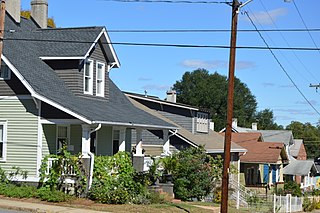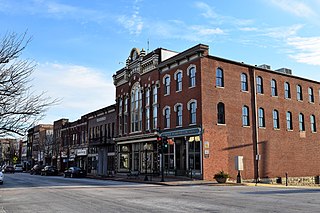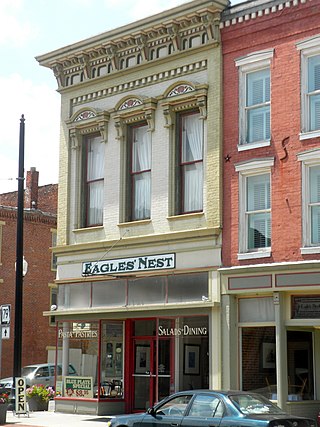
The Lower Highlands Historic District encompasses one of the oldest residential areas of Fall River, Massachusetts. The district is roughly bounded by Cherry, Main, Winter, and Bank Streets, and is located just east of the Downtown Fall River Historic District and directly south of the Highlands Historic District. This area was settled by 1810, has architecture tracing the city's growth as a major industrial center. The historic district was added to the National Register of Historic Places in 1984.

The Governor's Mansion Historic District is a historic district covering a large historic neighborhood of Little Rock, Arkansas. It was listed on the National Register of Historic Places in 1978 and its borders were increased in 1988 and again in 2002. The district is notable for the large number of well-preserved late 19th and early 20th-century houses, and includes a major cross-section of residential architecture designed by the noted Little Rock architect Charles L. Thompson. It is the oldest city neighborhood to retain its residential character.

McNutt Rural Historic District is located in Rapides Parish, Louisiana around the intersection of Belgard Bend Rd. and Louisiana Highway 121 that make up the rural community of McNutt, Louisiana. It was added to the National Register of Historic Places on September 15, 1988. McNutt is named from "McNutt Hill," itself named for Isaac McNut], the son-in-law of John Texada, a federal land agent in the area in the early 1800s.

The Hillside Historic District in Waterbury, Connecticut is a 106-acre (43 ha) historic district that was listed on the National Register of Historic Places (NRHP) in 1987. It encompasses a residential area north of the city's central business district, and is bounded on the south by West Main Street, the west by Willow Avenue and Cliff and Frederick Streets, on the north by Buckingham Street and Woodland Terrace, and on the east by Cooke Street. Developed principally over an 80-year period between 1840 and 1920, it includes a cross-section of architectural styles of the 19th and early 20th centuries. The area was a desirable neighborhood of the city for much of this time, and was home to a number of the city's elite. In 1987, it included 395 buildings deemed to contribute to the historic character of the area, and one other contributing structure. It includes the Wilby High School and the Benedict-Miller House, which are both separately listed. 32 Hillside Road, a several acre property that includes the Benedict Miller House, was the original site of The University of Connecticut's Waterbury Branch until 2003.

The St. Charles Historic District is a national historic district located at St. Charles, St. Charles County, Missouri. It is the site of the first permanent European settlement on the Missouri River and of the embarkation of Lewis and Clark's journey of exploration along the Missouri. The first state capital of Missouri and over one hundred other historic buildings are located in the district.

North Battersea-Pride's Field Historic District is a national historic district located at Petersburg, Virginia. The district includes 156 contributing buildings and 2 contributing sites located in a predominantly residential section of Petersburg. It includes a varied collection of mid- to late 19th- and early 20th-century middle and working-class houses and includes notable examples of Queen Anne and Gothic Revival style architecture. Notable buildings include the late-18th century stone toll keeper's house, Montview, Pride's Tavern dependency, and West Street Presbyterian Chapel.

West Salem Historic District is a national historic district located at Winston-Salem, Forsyth County, North Carolina. The district encompasses 591 contributing buildings, 1 contributing site, and 3 contributing structures in a largely residential section of Winston-Salem. The buildings date from about 1843 to 1957, and include notable examples of Colonial Revival, Queen Anne, and American Craftsman style architecture, as well as bungalows. Notable resources include the M. D. Gantt Building (1931), Coca-Cola bottling plant (1930), Christ Moravian Church (1895), and Green Street Methodist Church (1921).

North Washington Street Historic District is a national historic district located in the city of Bloomington of Monroe County, Indiana. The district encompasses 35 contributing buildings and 6 contributing structures in a predominantly residential section of Bloomington. It developed between roughly 1870 and 1929, and includes notable examples of Queen Anne, Classical Revival, and Bungalow/American Craftsman style architecture. Located in the district is the separately listed Morgan House. Other notable buildings include the Showers-Graham House, Showers-Myers House, Teter House, and Washington Terrace Apartments (1929).

Rising Sun Historic District is a national historic district located at Rising Sun, Ohio County, Indiana. The district encompasses 322 contributing buildings, 2 contributing sites, and 2 contributing objects in Rising Sun. It developed between about 1810 and 1955, and includes notable examples of Federal, Italianate, and Classical Revival style architecture. Located in the district are the separately listed Clore Plow Works-J.W. Whitlock and Company buildings. Other notable contributing resources include the First Presbyterian Church (1843), Ohio County Courthouse (1845), Alexander C. Downey House, Rising Sun Cemetery, and Robert E. Covington House.

North Meridian Street Historic District is a national historic district located at Indianapolis, Indiana. It encompasses 169 contributing buildings in a high style residential section of Indianapolis. The district developed between about 1900 and 1936, and includes representative examples of Tudor Revival, Colonial Revival, and Classical Revival style architecture. Located in the district is the separately listed William N. Thompson House. Other notable contributing resources include the Evan-Blankenbaker House (1901), Sears-Townsend House (1930), MacGill-Wemmer House, Hugh Love House (1930), Hare-Tarkington House (1911), Shea House (1922), and Brant-Weinhardt House (1932).

North Main Street Historic District is a national historic district located at Poplar Bluff, Butler County, Missouri. It encompasses 19 contributing buildings and 1 contributing structure in a predominantly residential section of Poplar Bluff. The district developed between about 1880 and 1954, and includes representative examples of Queen Anne, Neo-Classical Revival, Colonial Revival, Late Gothic Revival, and Bungalow / American Craftsman style architecture. Located in the district is the separately listed Moore-Dalton House. Other notable buildings include the Holy Cross Episcopal Church and the Zion Lutheran Church.
Cynthia–Kinzer Historic District is a national historic district located around Cynthia and Kinzer Streets, Poplar Bluff, Missouri. It encompasses 55 contributing buildings 1 contributing site, and 17 contributing structures in a predominantly residential section of Poplar Bluff. The district developed between about 1907 and 1961, and includes representative examples of Colonial Revival, Tudor Revival, Bungalow / American Craftsman, and International style architecture. Located in the district are the separately listed Alfred W. Greer House and J. Herbert Moore House. Other notable buildings include the Fred Anderson House, Hubert C. Roland House, Lyle Kutchback House, Lawrence and Alma Tedrick House, C.P. Schultz House, J. Truman and Lena Carter House, Carl Capps House, and James and Nelda McPheeters House.

Court Street Historic Residential District is a national historic district located at Fulton, Callaway County, Missouri. It encompasses 84 contributing buildings in a predominantly residential section of Fulton. It developed between about 1844 and 1945, and includes representative examples of Queen Anne, Second Empire, Colonial Revival, American Foursquare, and Bungalow style architecture. Some of the buildings were designed by noted local architect Morris Frederick Bell. Located in the district is the separately listed Brandon-Bell-Collier House. Other notable buildings include the John W. Tucker Residence (1912), Klinginsmith Residence, Synodical College-Seminole Apartments, Synodical College Dormitory-Seminole Apartments (1913), Gish Residence, Dave and Ida McCue House, First Presbyterian Church, Leland Waters Residence, Bauer House, and Martin-Harris House.

Missouri State Capitol Historic District is a national historic district located at Jefferson City, Cole County, Missouri. It encompasses 122 contributing buildings in the central business district of Jefferson City. The district developed between about 1850 and 1950, and includes representative examples of Classical Revival, Late Victorian, Queen Anne, Mission Revival, and Modern Movement style architecture. Located in the district are the separately listed Missouri State Capitol, Lohman's Landing Building, Cole County Historical Society Building, Cole County Courthouse and Jail-Sheriff's House, Missouri Governor's Mansion, and Tergin Apartment Building. Other notable buildings include the St. Peter's Roman Catholic Church complex (1881-1883), Margaret Upshulte House, Broadway State Office Building (1938), Supreme Court of Missouri (1905-1906), U.S. Post Office and Courthouse (1932-1934), Lohman's Opera House, Missouri State Optical, First United Methodist Church (1900), Carnegie Public Library (1901), Temple Beth El (1883), and Joseph and Susie Kolkmeyer House.

Central Park Historic District is a national historic district located at Hannibal, Marion County, Missouri. The district encompasses 261 contributing buildings, 1 contributing site, and 4 contributing structures in a predominantly residential section of Hannibal. It developed between about 1840 and 1939, and includes representative examples of Romanesque Revival, Late Victorian, and Art Deco architecture. Located in the district are the separately listed Federal Building, Hannibal Old Police Station and Jail, and Eighth and Center Streets Baptist Church. Other notable contributing resources include Central Park with a war memorial monument and a life-size bronze statue of William Henry Hatch (1833-1894), City Hall (1909), old Missouri Guaranty Building (1894), Price Apartments (1904), YMCA (1910), Masonic Temple (1882), Park Methodist Church, Retards Row (1855), Elks Building (1925), Holmes Building, Security Building (1912), Kerchival-Iakenan-Lathrop House, Admiral Coontz Birthplace, Inmaculate Conception Chapel (1854), Episcopalian Trinity Church (1860), and William C. Henn House (1937).

The Sedalia Commercial Historic District is a national historic district located at Sedalia, Pettis County, Missouri. It encompasses 102 contributing buildings in the central business district of Sedalia. The district developed between about 1870 and 1959, and includes representative examples of Italianate, Romanesque Revival, and Art Deco architecture. Located in the district are the separately listed Hotel Bothwell, Building at 217 West Main Street, and Missouri/Sedalia Trust Company. Other notable buildings include the First United Methodist Church (1888-1891), Pettis County Courthouse (1924), Anheuser Busch Bottling Works, the New Lona Theater (1920), Citizens National Bank Building, Third National Bank (1929), Federal Building (1930), Montgomery Ward Building (1936), the Uptown Theatre (1936), Missouri Pacific Depot, and Central Presbyterian Church.

Georgia Street Historic District is a national historic district located at Louisiana, Pike County, Missouri. The district encompasses 55 contributing buildings in the central business district of Louisiana. It developed between about 1845 and 1935, and includes representative examples of Greek Revival, Italianate, and Classical Revival style architecture. Notable buildings include the Masonic Temple (1910), Odd Fellows lodge (1890), and Post Office (1905).

Midtown Neighborhood Historic District is a national historic district located at St. Charles, St. Charles County, Missouri. The district encompasses 527 contributing buildings, 7 contributing sites, and 5 contributing objects in a predominantly residential section of St. Charles. It developed between about 1838 and 1959, and includes representative examples of Federal, Greek Revival, Gothic Revival, Italianate, Queen Anne, Romanesque Revival, Folk Victorian, Colonial Revival, Classical Revival, Tudor Revival, and Bungalow / American Craftsman style architecture. Located in the district are the separately listed African Church and Oliver L. and Catherine Link House. Other notable buildings include the St. Charles County Courthouse, Benton School (1896), St. John's A.M.E. Church (1872), Immanuel Lutheran Church (1867), Jefferson Street Presbyterian Church, Fourth Street Market Grocery (1926-1927), West End Grocery and Meat Market, Dr. Ludwell Powell House (1838), Rogers-Ehrhard House, Waye Monument Company and Residence (1889), Meyer House, Kaemmerlen House, and Elsner House.

The New Orleans Lower Central Business District is a historic district in New Orleans, Louisiana, which was listed on the National Register of Historic Places (NRHP) in 1991. It may be referred to as Lower Central Business District. Along with the NRHP-listed New Orleans Upper Central Business District to the south, across the redeveloped Poydras Street, it is included within the larger New Orleans Central Business District area. To the north, between N. Peters and N. Rampart, the district borders the historic, NRHP-listed Vieux Carre, which is a U.S. National Historic Landmark.

The Asbury Historic District is a 288-acre (117 ha) historic district encompassing the community of Asbury in Franklin Township of Warren County, New Jersey. It is bounded by County Route 632, County Route 643, Maple Avenue, Kitchen Road, and School Street and extends along the Musconetcong River into Bethlehem Township of Hunterdon County. It was listed on the National Register of Historic Places on March 19, 1993 for its significance in architecture, industry, religion, community development, politics/government, and commerce. The district includes 141 contributing buildings, a contributing structure, two contributing sites, and four contributing objects.























